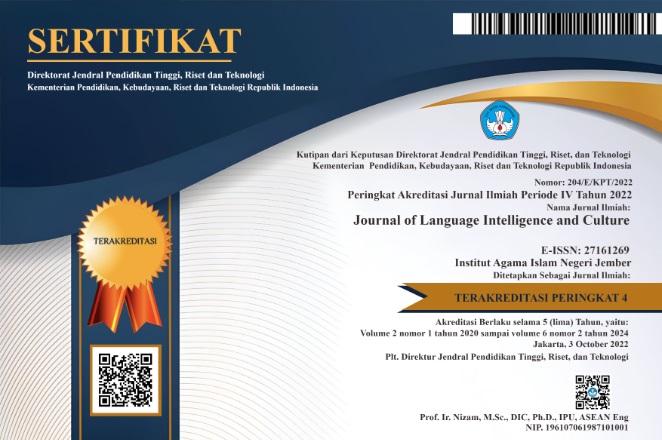The Correlation Between Students` Critical Thinking and Speaking Skill in English Class at Diploma 4 of The Health Promotion Study Program
DOI:
https://doi.org/10.35719/jlic.v6i1.145Keywords:
English class, speaking skills, critical thinkingAbstract
English is a crucial medium of communication, with fluency in four language skills: listening, speaking, reading, and writing. Speaking is one of the most challenging skills, as it allows students to engage in conversations, express meaning, and express opinions. Thinking is a key factor in developing speaking abilities, as it helps individuals solve issues, make decisions, and achieve goals. This research aimed to measure the correlation between students' critical thinking and their speaking skills. A quantitative study of 14 first-semester students of the Diploma 4 Health Promotion study program at Sari Mulia University found a weak correlation (rho coefficient 0.209, sig. score 0.494). The results reject the alternative hypothesis (Ha), indicating that there is no significant correlation between students' critical thinking and speaking ability, confirming the null hypothesis (Ho), is accepted.
References
Brown, H. D., & Abeywickrama, P. (2018). Language assessment?: principles and classroom practices. 376.
Cottrell, S. (2005). Where ’ s the Proof?? Finding and evaluating sources of evidence [ and texts for activities ] Where ’ s the proof?? Finding and evaluating sources of evidence. 125–146. https://books.google.com/books/about/Critical_Thinking_Skills.html?id=QYOBQgAACAAJ
Ennis, R. H. (2011). The Nature of Critical Thinking: An Outline of Critical Thinking Dispositions and Abilities i.
Fisher, A. (2011). CRITICAL THINKING: Fallacies. Cambridge University Press, Part II, 36–37. https://www.dropbox.com/s/n7fbemzqxmvyabh/FISHER-Critical thinking.pdf?dl=0
Fulcher, G. (2014). Testing second language speaking. In Testing Second Language Speaking. Taylor and Francis. https://doi.org/10.4324/9781315837376/TESTING-SECOND-LANGUAGE-SPEAKING-GLENN-FULCHER
Navidinia, H., Mobaraki, M., & Malekzadeh, F. (2019). Investigating the Effect of Noticing on EFL Students’ Speaking Accuracy. International Journal of Instruction, 12(1), 83–98. https://doi.org/10.29333/iji.2019.1216a
Pratiwi, A. (2018). THE CORRELATION BETWEEN STUDENTS’ CRITICAL THINKING AND VOCABULARY MASTERY AT SMAN 3 PALANGKA RAYA.
Rahmawati, A. (2018). Efl Students; Critical Thinking in Speaking Activities (a Descriptive Study at English Conversation Club (Ecc) in Sman 1 Maja). Journal of English Language Learning, 2(2), 318851. https://www.neliti.com/publications/318851/
Sarigoz, O. (2012). Assessment of the High School Students’ Critical Thinking Skills. Procedia - Social and Behavioral Sciences, 46, 5315–5319. https://doi.org/10.1016/j.sbspro.2012.06.430
Schober, P., Boer, C., & Schwarte, L. A. (2018). Correlation Coefficients: Appropriate Use and Interpretation. Anesthesia and Analgesia, 126(5), 1763–1768. https://doi.org/10.1213/ANE.02864
Tanner, D. E. (2012). Using Statistics to Make Educational Decisions. https://doi.org/10.4135/9781452240596
Downloads
Published
How to Cite
Issue
Section
License
Copyright (c) 2024 Indri Puspita Dewi, Noor Aisyah, Faida Azhimia, Nur Rahmadani

This work is licensed under a Creative Commons Attribution-ShareAlike 4.0 International License.













